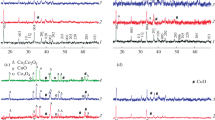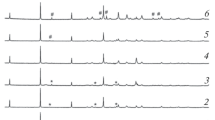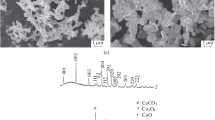Abstract
A phase-heterogeneous ceramic based on layered calcium cobaltite Ca3Co4O9+δ was prepared by solid-phase reactions followed by hot pressing. The phase composition, microstructure, electrical conductivity, and thermoelectromotive force (thermo-emf) of the ceramic were studied, and the power factor (P) was calculated. Hot pressing allows preparation of a high-density ceramic with high electrical conductivity, and the phase heterogeneity considerably increases its thermo-emf coefficient, which in total can be considered as a procedure for preparing a ceramic with improved thermoelectric characteristics. The ceramic of the nominal composition Ca3Co4.4O9+δ, containing an impurity Co3O4 phase, has the highest power factor (P1100 = 427 μW m–1 K–2), which is 1.5 times higher than that of Ca3Co4O9+δ (P1100 = 280 μW m–1 K–2) and more than 4 times higher than that of the low-density ceramic Ca3Co4O9+δ prepared by the traditional solid-phase method.
Similar content being viewed by others
Avoid common mistakes on your manuscript.
The heat released into the environment in the course of operation of industrial enterprises, transport vehicles, and various devices and machines can be converted directly to electric power using thermoelectric generators. Their fabrication requires materials (thermoelectrics) combining high levels of electrical conductivity (σ) and thermoelectromotive force (thermo-emf) (S) with low thermal conductivity [1]. Traditional thermoelectrics are bismuth, antimony, lead, and tin chalcogenides and solid solutions based on them [1–3], which are characterized by high values of the power factor (P) and figure-of-merit (ZT) and are widely used in various thermoelectric devices. The drawbacks of these materials are high content of toxic and expensive components and low resistance to oxidation with atmospheric oxygen at high temperatures. Oxide thermoelectrics, including layered calcium cobaltite Ca3Co4O9+δ, which is considered today as a promising base for the development of р-branches of high-temperature thermoelectric generators, are free of these drawbacks [4].
The functional (thermoelectric) characteristics of the ceramic based on Ca3Co4O9+δ can be improved by the use of “mild” low-temperature synthesis procedures [5–8] instead of traditional ceramic procedure, by the use of special procedures in the course of ceramic sintering such as hot pressing [6] or spark plasma sintering [7, 9, 10], by partial replacement of calcium ions in Ca3Co4O9+δ by bismuth [11, 12] or rare earth element ions [13, 14] or of cobalt ions by transition or heavy metal ions [15, 16], and by creation of chemical [17] or phase heterogeneity [18, 19] in the ceramic.
In a ceramic based on layered calcium cobaltite, the phase heterogeneity can be created both by introducing a second impurity phase into the charge in the synthesis step [20–22] and by varying the cationic stoichiometry of the initial charge so that the target composition be beyond the Ca3Co4O9+δ homogeneity area (self-doping) [23] (according to [24], layered calcium cobaltite exists in air in the composition range Ca3Co3.87O9+δ–Ca3Co4.07O9+δ), and also by annealing the ceramic at temperatures exceeding the temperature of the peritectoid decomposition of Ca3Co4O9+δ (Тp = 926°С [24]) by the reaction Ca3Co4O9+δ ↔ Са3Со2О6 + (Со,Са)О.
In this study, we examined the possibility of improving the functional (thermoelectric) characteristics of the ceramic based on layered calcium cobaltite by making it phase-heterogeneous via self-doping combined with hot pressing.
EXPERIMENTAL
Powders of the compositions Ca3Co3.6O9+δ, Ca3Co4O9+δ, and Ca3Co4.4O9+δ were prepared by solid-phase reactions from CaCO3 (analytically pure grade) and Co3O4 (pure grade), taken in the corresponding stoichiometric ratios, in air at 1173 K for 12 h as described in [12, 18]. The sintered ceramic in the form of pellets 20 mm in diameter and 2–5 mm thick were prepared by hot pressing with a DSP-507 installation (Dr. Fritsch, Germany) under argon at 1173 K under a pressure of 167 MPa for 5 min. After hot pressing, the samples were additionally annealed in air for 14 h at 973 K. Specimens in the form of rectangular parallelepipeds of size 4 × 4 × 7 and 4 × 4 × 20 mm were cut from the sintered ceramic for measuring the electrical conductivity and thermo-emf, and Ag electrodes were formed on the end faces of these specimens [25].
The phase composition of the samples and the parameters of the crystal structure of the major phase were determined by X-ray diffraction (XRD) analysis with an STOE Theta/Theta diffractometer (Germany) (CoKα radiation) and an RTP X-ray diffraction table processor [26]. The microstructure of the sintered ceramic and its chemical composition were studied by scanning electron microscopy (SEM) with SEM 7500F Jeol and JSM-5610 LV scanning electron microscopes equipped with an EDX JED-220 chemical analysis system (Tokyo, Japan).
The apparent density (ρapp) of the sintered ceramic was determined from the sample weight and size. The sample porosity was calculated by the formula П = (1 – ρapp/ρXRD) × 100%, where ρXRD is the X-ray diffraction density of the sample (ρXRD = 4.677 g cm–3 [27]).
The electrical conductivity and thermo-emf of the materials were determined in the direction perpendicular to the pressing axis in air in the temperature interval 300–1100 K by the procedures described in [25]. The activation energy of the electrical conductivity (Еа) of the samples was determined from the linear portions of the dependences ln (σT) = f(1/T). The power factor of the thermoelectrics was calculated by the formula P = S2σ [4].
The temperature conductivity (η) of the Ca3Co3.6O9+δ and Ca3Co4O9+δ samples was measured in the direction parallel to the pressing axis at 299 K by the laser flash method with a Linseis LFA 1000 installation (Germany). The thermal conductivity (λ) of the samples was determined by the equation λ = η?ρappcsp from the experimentally determined values of the temperature conductivity and apparent density; the specific heat capacity (csp) was calculated using data from [24]. The phonon (λph) and electron (λe) contributions to the thermal conductivity of the ceramic was calculated using the relationships λ = λph + λe, λe = σLT, where σ is the specific electrical conductivity of the ceramic, L is the Lorenz number (L = 2.45 × 10–8 V2 K–2), and T is the absolute temperature. The quantity ZT was found using the equation ZT = (PT)/λ [2, 4].
RESULTS AND DISCUSSION
Analysis of the elemental composition of the ceramic (Table 1) shows that the composition of the heat-treated samples corresponded to the preset nominal composition of the charge within the error of the EDX microanalysis.
After the synthesis completion, the ceramic, according to the XRD data, was not single-phase. The powder X-ray diffraction patterns (Fig. 1) contained, along with pronounced reflections of the major phase, layered calcium cobaltite Ca3Co4O9+δ [28], also the reflections of impurity phases: Ca3Co2O6 [29] for the samples of the composition Ca3Co3.6O9+δ and Ca3Co4O9+δ; Co3O4Footnote 1 for the sample of the composition Ca3Co4.4O9+δ.
The crystal lattice parameters of the major phase (Ca3Co4O9+δ) in ceramics of different compositions are close (Table 2) and agree with the published data, according to which for Ca3Co4O9+δ a = 0.48376(7) nm, b1 = 0.45565(6) nm, b2 = 0.28189(4) nm, c = 1.0833(1) nm, and β = 98.06(1)° [28]. At the same time, a slight increase in the parameters a and β of layered calcium cobaltite on deviation of the Ca : Co ratio from the stoichiometric value (3 : 4) should be noted.
The apparent density of the ceramics prepared by hot pressing was 4.215, 4.308, and 4.130 g cm–3 for samples of the compositions Ca3Co3.6O9+δ, Ca3Co4O9+δ, and Ca3Co4.4O9+δ, respectively, which corresponds to the porosity of 9.9, 7.9, and 11.7%. The results obtained allow two conclusions: firstly, the use of hot pressing allows preparation of a low-porosity (П ~ 10%) thermoelectric ceramic based on layered calcium cobaltite Ca3Co4O9+δ; second, creation of the phase heterogeneity in the material by self-doping impairs, though not very significantly, its sinterability.
The ceramics of the compositions Ca3Co3.6O9+δ and Ca3Co4O9+δ had layered microstructure and consisted of well crystallized plates (flakes) of 8–10 μm size with a thickness of approximately 1 μm, partially aggregated in stacks and oriented predominantly in the direction perpendicular to the pressing axis (Figs. 2a, 2b). The anisometric shape of the crystallites of the major phase (layered calcium cobaltite Ca3Co4O9+δ) in the ceramic of the nominal composition Ca3Co4.4O9+δ was less pronounced (Fig. 2c); the crystallite size varied in a wide range, and the crystallites were partially aggregated in stacks near which small (of approximately 1 μm size) almost isometric particles of the impurity phase, cobalt oxide Co3O4 [18], could be seen. The Ca3Co4.4O9+δ sample had a large number of pores (Fig. 2), in agreement with the results of determining the apparent density of the ceramic.
At temperatures close to room temperature, the ceramic exhibited the metal conductivity (∂σ/∂T < 0), which changed to semiconductor conductivity (∂?/?σ/∂T > 0) at approximately 500 K (Fig. 3a); the activation energy of the electrical conductivity in the temperature interval 600–1100 K was 0.054(2), 0.051(1), and 0.044(2) eV for the Ca3Co3.6O9+δ, Ca3Co4O9+δ, and Ca3Co4.4O9+δ samples, respectively, which well agrees with the value of Eа ~ 0.05 eV, found by Zhou et al. [23] for the ceramic of the composition Ca3Co4±xO9+δ (x = 0–0.4). The close values of Eа for the materials that we studied suggest a common mechanism of the electrical conductivity, determined by the charge transfer within the major phase, layered calcium cobaltite. The specific electrical conductivity of the ceramic was considerably higher [σ300 ~ 45–111 S cm–1 (Fig. 3a)] than that of the materials prepared by the common solid-phase or citrate method (σ300 ~ 20–25 S cm–1 [8, 12, 14, 16, 18]), which is caused by its low porosity; the conductivity strongly increased with an increase in the cobalt oxide content (in particular, the electrical conductivity of the phase-heterogeneous ceramic of the composition Ca3Co4.4O9+δ, containing cobalt oxide Co3O4 as an impurity phase, throughout the examined temperature interval was 40–60% higher than that of the base compound, layered calcium cobaltite Ca3Co4O9+δ) (Fig. 3a).
The thermo-emf coefficient of the materials studied was positive (S > 0); this means that the main charge carriers in them are holes. This coefficient increased with temperature also for the samples containing an excess amount of calcium or cobalt oxide relative to the stoichiometry, being appreciably (by 5–20%) higher than that for Ca3Co4O9+δ (Fig. 3b). Thus, creation of the phase heterogeneity in the ceramic based on layered calcium cobaltite (in particular, owing to introduction of less conducting phases, Ca3Co2O6 or Co3O4) allows its thermo-emf coefficient to be appreciably increased.
The power factor of the ceramics studied increased with temperature. It was close for the Ca3Co3.6O9+δ and Ca3Co4O9+δ samples and appreciably higher for Ca3Co4.4O9+δ (Fig. 3c), which is due to high values of its specific electrical conductivity and thermo-emf coefficient. The highest power factor was observed for the phase-heterogeneous ceramic of the composition Ca3Co4.4O9+δ (Ca3Co4O9+δ + Co3O4): P1100 = 427 μW m–1 K–2, which is 1.5 times higher than for the ceramic Ca3Co4O9+δ prepared by the same method (P1100 = 285 μW m–1 K–2) and more than 4 times higher than for the low-density ceramic Ca3Co4O9+δ prepared by the traditional solid-phase method (P1100 = 100 μW m–1 K–2 [16]).
The temperature conductivity of the Ca3Co4O9+δ and Ca3Co3.6O9+δ samples at 299 K was 7.69 × 10–7 and 8.93 × 10–7 m2 s–1, respectively, and the thermal conductivity values calculated on their basis are 3.22 and 3.66 W m–1 K–1. Such values are characteristic of high-density (low-porosity) ceramic based on layered calcium cobaltite [8]. Because the Ca3Co4O9+δ sample is characterized by higher apparent density (lower porosity) than the Ca3Co3.6O9+δ sample, higher values of the temperature and thermal conductivity of the latter sample are probably due to the presence of the impurity Ca3Co2O6 phase. The electronic contribution to the thermal conductivity of the ceramics Ca3Co4O9+δ and Ca3Co3.6O9+δ was 34.36 and 12.31 mW m–1 K–1, and the phonon contribution, 3.18 and 3.64 W m–1 K–1, respectively. That is, the electronic constituent of the thermal conductivity is low (λe/λ = 0.3–1.1%) and the phonon conductivity prevails (λph/λ = 98.9–99.7%), which is characteristic of materials of this type [12, 14].
The figure-of-merit of the sample with excess calcium oxide, Ca3Co3.6O9+δ, at 299 K was 0.00836 and was lower than for the base compound, layered calcium cobaltite Ca3Co4O9+δ (0.00955), which is caused by lower specific electrical conductivity and higher thermal conductivity of this material.
CONCLUSIONS
The creation of the phase heterogeneity in a ceramic based on layered calcium cobaltite Ca3Co4O9+δ by self-doping allows the thermo-emf coefficient of the materials to be appreciably increased. The quantity S for the samples self-doped with calcium oxide (Ca3Co2O6 impurity phase) increases to a greater extent than in self-doping with cobalt oxide (Co3O4 impurity phase). Hot pressing allows preparation of a ceramic exhibiting low porosity (П = 8–12%) and therefore increased electrical conductivity. Joint use of self-doping and hot pressing leads to the formation of a ceramic with improved functional (thermoelectric) characteristics. For example, among the samples studied, the phase-heterogeneous ceramic of the composition Ca3Co4.4O9+δ, containing cobalt oxide Co3O4 as an impurity phase, has the highest power factor, 427 μW m–1 K–2 at 1100 K, which is 1.52 times higher than for the Ca3Co4O9+δ sample (P1100 = 280 μW m–1 K–2) and 4.27 times higher than for the low-density (П = 25%) ceramic Ca3Co4O9+δ prepared by the common procedure (P1100 = 100 μW m–1 K–2 [16]).
Notes
Powder Diff raction File, Swarthmore: Joint Committee on Рowder Diff raction Standard, card no. 00-042-1467.
REFERENCES
Zhou, Y. and Zhao, L.-D., Adv. Mater., 2017, vol. 29, no. 45, p. 1702676. https://doi.org/10.1002/adma.201702676
CRC Handbook of Thermoelectrics, Rowe, D.M., Ed., Boca Raton, FL: CRC, 1995.
Ivanov, V.A., Gremenok, V.F., Seidi, H.G., Zimin, S.P., and Gorlachev, E.S., Nanosyst.: Phys., Сhem., Math., 2013, vol. 4, no. 6, pp. 816–822.
Oxide Thermoelectrics, Koumoto, K., Terasaki, I., and Murayama, N., Eds., Trivandrum: Research Signpost, 2002.
Sotelo, A., Constantinescu, G., Rasekh, Sh., Torres, M.A., Diez, J.C., and Madre, M.A., J. Eur. Ceram. Soc., 2012, vol. 32, pp. 2415–2422. https://doi.org/10.1016/j.jeurceramsoc.2012.02.012
Katsuyama, S., Takiguchi, Y., and Ito, M., J. Mater. Sci., 2008, vol. 43, pp. 3553–3559. https://doi.org/10.1007/s10853-008-2561-x
Wu, N.Y., Holgate, T.C., Nong, N.V., Pryds, N., and Linderot, S., J. Eur. Ceram. Soc., 2014, vol. 34, pp. 925–931. https://doi.org/10.1016/j.jeurceramsoc.2013.10.022
Królicka, A.K., Piersa, M., Mirowska, A., and Michalska, M., Ceram. Int., 2018, vol. 44, no. 12, pp. 13736–13743. https://doi.org/10.1016/j.ceramint.2018.04.215
Zhang, Y. and Zhang, J., J. Mater. Process. Technol., 2008, vol. 208, pp. 70–74. https://doi.org/10.1016/j.jmatprotec.2007.12.093
Liu, Y., Lin, Y., Shi, Z., and Nan, C.-W., J. Am. Ceram. Soc., 2005, vol. 88, no. 5, pp. 1337–1340. https://doi.org/10.1111/j.1551-2916.2005.00284.x
Li, S., Funahashi, R., Matsubara, I., Ueno, K., Sodeoka, S., and Yamada, H., Chem. Mater., 2000, vol. 12, pp. 2424–2427. https://doi.org/10.1021/cm000132r
Matsukevich, I.V., Klyndyuk, A.I., Tugova, E.A., Kovalenko, A.N., Marova, A.A., and Krasutskaya, N.S., Inorg. Mater., 2016, vol. 52, no. 6, pp. 593–599. https://doi.org/10.1134/S0020168516060091
Prevel, M., Perez, O., and Noudem, J.G., Solid State Sci., 2007, vol. 9, pp. 231–235. https://doi.org/10.1016/j.solidstatesciences.2007.01.003
Klyndyuk, A.I. and Matsukevich, I.V., Inorg. Mater., 2012, vol. 48, no. 10, pp. 1052–1057. https://doi.org/10.1134/S0020168512090099
Wang, Y., Sui, Y., Ren, P., Wang, L., Wang, X., Su, W., and Fan, H., Chem. Mater., 2010, vol. 22, pp. 1155–1163. https://doi.org/10.1021/cm902483a
Klyndyuk, A.I. and Matsukevich, I.V., Inorg. Mater., 2015, vol. 51, no. 9, pp. 944–950. https://doi.org/10.1134/S0020168515080105
Carvillo, P., Chen, Y., Boyle, C., Barnes, P.N., and Song, X., Inorg. Chem., 2015, vol. 54, pp. 9027–9032. https://doi.org/10.1134/S0020168515080105
Matsukevich, I.V., Klyndyuk, A.I., Tugova, E.A., Tomkovich, M.V., Krasutskaya, N.S., and Gusarov, V.V., Russ. J. Appl. Chem., 2015, vol. 88, no. 8, pp. 1241–1247. https://doi.org/10.1134/S1070427215080030
Delorme, F., Diaz-Chao, P., Guilmeau, E., and Giovannelli, F., Ceram. Int., 2015, vol. 41, no. 8, pp. 10038–10043. https://doi.org/10.1016/j.ceramint.2015.04.091
Rasekh, Sh., Ferreira, N.M., Costa, F.M., Constantinescu, G., Madre, M.A., Torres, M.A., Diez, J.C., and Sotelo, A., Scripta Mater., 2014, vol. 80, pp. 1–4. https://doi.org/10.1016/j.scriptamat.2014.01.032
Jankowski, O., Huber, S., Sedmidubsky, D., Nadherny, L., Hlasek, T., and Sofer, Z., Ceramics–Silikaty, 2014, vol. 58, no. 2, pp. 106–110.
Gupta, R.K., Sharma, R., Mahapatro, A.K., and Tandon, R.P., Physica B, 2016, vol. 483, pp. 48–53. https://doi.org/10.1016/j.physb.2015.12.028
Zhou, X.-D., Pederson, L.R., Thomsen, E., Nie, Z., and Coffey, G., Electrochem. Solid-State Lett., 2009, vol. 12, no. 2, p. F1–F3. https://doi.org/10.1149/1.3039948
Sedmidubsky, D., Jakes, V., Jankovsky, O., Leitner, J., Sofer, Z., and Hejtmanek, J., J. Solid State Chem., 2012, vol. 194, pp. 199–205. https://doi.org/10.1016/j.jssc.2012.05.014
Klyndyuk, A.I. and Chizhova, Ye.A., Funct. Mater., 2009, vol. 16, no. 1, pp. 17–22.
Zatsiupa, A.A., Bashkirov, L.A., Petrov, G.S., Lobanovskii, L.S., and Trukhanov, S.V., Glass Phys. Chem., 2013, vol. 39, no. 5, pp. 589–596. https://doi.org/10.1134/S1087659613050192
Madre, M.A., Costa, F.M., Ferreira, N.M., Sotelo, A., Torres, M.A., Constantinescu, G., Rasekh, Sh., and Diez, J.C., J. Eur. Ceram. Soc., 2013, vol. 33, pp. 1747–1754. https://doi.org/10.1016/j.jeurceramsoc.2013.01.029
Masset, A.C., Michel, C., Maignan, A., Hervieu, M., Toulemonde, O., Studer, F., and Raveau, B., Phys. Rev. B, 2000–I, vol. 62, no. 1, pp. 166–175.
Mikami, M. and Funahashi, R., J. Solid State Chem., 2005, vol. 178, pp. 1670–1674. https://doi.org/10.1016/j.jssc.2005.03.004
ACKNOWLEDGMENTS
The authors are grateful to Tomanová Katarína (Slovak University of Technology in Bratislava) for examination of the samples by scanning electron microscopy.
Funding
The study was supported by the State Research Program “Physical Materials Sciences, New Materials and Technologies” (subprogram: Materials Science and Materials Technologies, task 1.55: Development and Study of Composite Thermoelectrics Based on Layered Calcium Cobaltite”) and by the National Scholarship Program of the Slovak Republic.
Author information
Authors and Affiliations
Corresponding author
Ethics declarations
The authors declare that they have no conflict of interest.
Rights and permissions
About this article
Cite this article
Klyndyuk, A.I., Matsukevich, I.V., Janek, M. et al. Thermoelectric Properties of a Phase-Heterogeneous Ceramic Based on Ca3Co4O9+δ, Prepared by Hot Pressing. Russ J Appl Chem 93, 1126–1131 (2020). https://doi.org/10.1134/S1070427220080030
Received:
Revised:
Accepted:
Published:
Issue Date:
DOI: https://doi.org/10.1134/S1070427220080030







